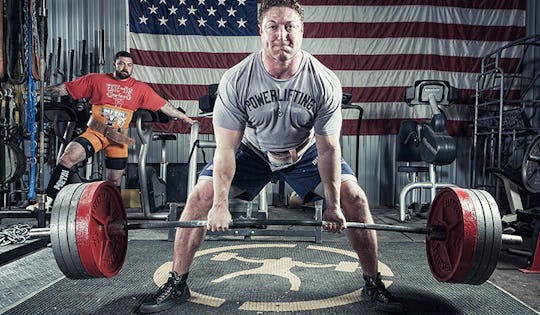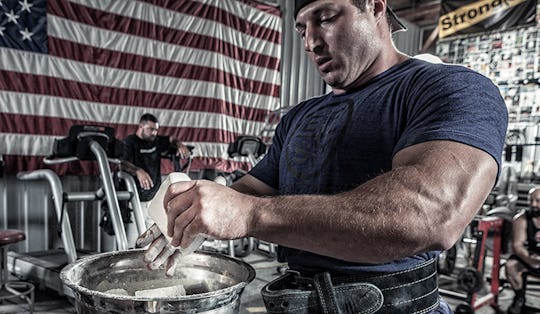 Joe Defranco wrote a great step by step write-up on how to Deadlift. I’ll try to expand on it with this article. Deadlifts can be the most rewarding and the most frustrating lift.
Joe Defranco wrote a great step by step write-up on how to Deadlift. I’ll try to expand on it with this article. Deadlifts can be the most rewarding and the most frustrating lift.
How hard can it be? Just pick the bar up off the floor, right? Well, kind of. More so than the Squat or Bench Press, overtraining the Deadlift can stop, or even reverse your progress.
Deadlifts will train a lot of the same muscle groups as the squat, but have the added advantage of training your grip, lats, and traps. There are two different Deadlift techniques you can use, and they will stress certain muscle groups differently.
Joe discussed a conventional Deadlift stance, with feet hip width. In powerlifting you are also allowed to use a sumo stance where your feet are nearly touching the plates and you grab the bar inside of your legs as opposed to outside of them.
Conventional Deadlifts will force you to use your low back, hamstrings, and even quads. Sumo Deadlifts will require more hip and glute activation. Both are great tools, regardless of your training goals.
Overtraining the Deadlift?
In training, have you ever had the experience of squatting 135 where it feels light, then you come in the next week and 135 feels heavy? It all revolves around your CNS and your ability to recover.
The Deadlift is exactly what it says- a dead lift. There is no eccentric phase (lowering the weight). In a Squat or Bench press you start by lowering the weight, then you reverse the weight (concentric phase).
A Deadlift is a concentric only lift. For that reason it stresses your Central Nervous System (CNS) more than other movements. Also, the stress Deadlifts add to your posterior chain is extremely taxing on your CNS.
Long story short, most people will begin to see diminishing returns on their Deadlifts if they train it every week. However, there are ways to trick your body. Pulling Sumo one week and conventional the next is an option.
Varying the heights from which you pull can help with this as well. Standing on a plate, making the pull longer, aka a Deficit Deadlift, can increase the difficulty of the movement.
Placing the bar on blocks or plates at 2”-6”, shortening the range of motion, is another option. Finally, placing the bar in a rack and starting the movement from the middle of your shin or top of your knee cap is another alternative.
Beginner Deadlift Program
| Sets x Reps | % of 1 rep max | Ex. 200# Deadlifter | |
| Week 1 | 5×5 | 70 | 140 |
| Week 2 | 4×4 | 75 | 150 |
| Week 3 | 3×3 | 80 | 160 |
| Week 4 | 5×1 | 50 | 100 |
| Week 5 | 5×2 | 85 | 170 |
| Week 6 | 4×2 | 90 | 180 |
| Week 7 | 3×2 | 95 | 190 |
| Week 8 | 3×1 | 100 | 200+ |
Intermediate Deadlift Program
| Pull From | Sets x Reps | % of 1 rep max | Ex. 400# Deadlifter | |
| Week 1 | The Floor | 5×5 | 70% | 280 |
| Week 2 | The Floor | 3×3 | 75% | 300 |
| Week 3 | The Floor | 3×1 | 80% | 320 |
| Week 4 | The Floor | 5×1 | 50% | 200 |
| Week 5 | Mid-Shin | 5×5 | 75% | 300 |
| Week 6 | Mid-Shin | 3×3 | 80% | 320 |
| Week 7 | Mid-Shin | 3×1 | 85% | 340 |
| Week 8 | Mid-Shin | 5×1 | 50% | 200 |
| Week 9 | Top 0f Knee |
5×5 | 90% | 360 |
| Week 10 | Top 0f Knee |
3×3 | 95% | 380 |
| Week 11 | Top 0f Knee |
3×1 | 100% | 400 |
| Week 12 | Top 0f Knee |
5×1 | 50% | 200 |
| Week 13 | 3×1 | 100+% | 400+ |
Advanced Deadlift Program
| Style | Sets x Reps | % of 1 rep max | Ex. 600# Deadlifter | |
| Week 1 | Sumo | 5×5 | 60% | 360 |
| Week 2 | Sumo | 4×4 8×1 30 sec |
65% | 390 |
| Week 3 | Conv. | rest | 60% | 360 |
| Week 4 | Conv. | 5×1 | 85% | 510 |
| Week 5 | Sumo | 5×5 | 65% | 390 |
| Week 6 | Sumo | 4×4 8×1 30 sec |
70% | 420 |
| Week 7 | Conv. | rest | 60% | 360 |
| Week 8 | Conv. | 5×1 | 90% | 540 |
| Week 9 | Sumo | 5×5 | 70% | 420 |
| Week 10 | Sumo | 4×4 8×1 30 sec |
75% | 450 |
| Week 11 | Conv. | rest | 50% | 300 |
| Week 12 | Conv. | 5×1 | 90% | 540 |
| Week 13 | Sumo | 5×5 | 70+% | 420 |
| Week 14 | Sumo | 4×4 8×1 60 sec |
80+% | 480 |
| Week 15 | Conv. | rest | 60+% | 360 |
| Week 16 | Conv. | 5×1 | 95+% | 570 |
| Week 17 | Sumo | 5×5 | 75+% | 450 |
| Week 18 | Sumo | 4×4 8×1 60 sec |
85+% | 510 |
| Week 19 | Conv. | rest | 50% | 300 |
| Week 20 | Conv. | test new max | 100+% | 600+ |


)





